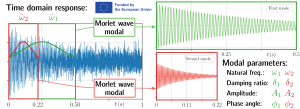Researchers of the Laboratory for Dynamics of Machines and Structures has developed a new method for identification of modal parameters from short, noisy and low dynamic range signals in time domain. Such signals are obtained from high-speed video recordings of the vibrating structure. The method is published in Mechanical Systems and Signal Processing journal (IF=8.934).
To meet the “Green Deal” in the transport and energy sectors, advanced lightweight structures that can withstand long lasting vibration loads without generating noise pollution need to be developed. To meet these challenges, modal parameters are used in the design phase to achieve optimal operating characteristics of the structure in terms of weight reduction, fatigue resistance and noise control. In the operational phase, the modal parameters are used to monitor the condition of the structure as they change with the deterioration of the structure. Wind turbines, aircraft and cars are such structures that are subjected to high dynamic loads during their operation.
Experimental modal analysis is a technique for determining modal parameters (natural frequencies, damping ratios and mode shapes) from measured structural vibrations. Nowadays, optical methods for measuring structural vibrations based on high-speed cameras are developing rapidly. They enable relatively fast, non-contact and dense measurement of structural vibrations, which is not possible with classical measurement methods (e.g. accelerometers). Dense measurement of vibrations enables the localisation of weak points in structures, with modal identification being an important step. However, identification from high-speed video is challenging and requires a new method because the identified displacements in the video recordings are highly noisy and have a low dynamic range. The published method was developed to overcome the challenges of modal identification using high-speed cameras by proposing a least-squares approach to make the identification error-resistant. The presented method simplifies the identification procedure and demonstrates that modal identification can be successfully performed from relatively short and low dynamic signals in the time domain that are heavily contaminated with noise. Furthermore, the method is implemented as a Python package MorletWaveModal, making it ready to use, and the source code is available on GitHub.

Figure 1: Modal identification using Morlet-wave integral
Link to the article: https://doi.org/10.1016/j.ymssp.2023.110243
Link to the source code: https://github.com/ladisk/MorletWaveModal